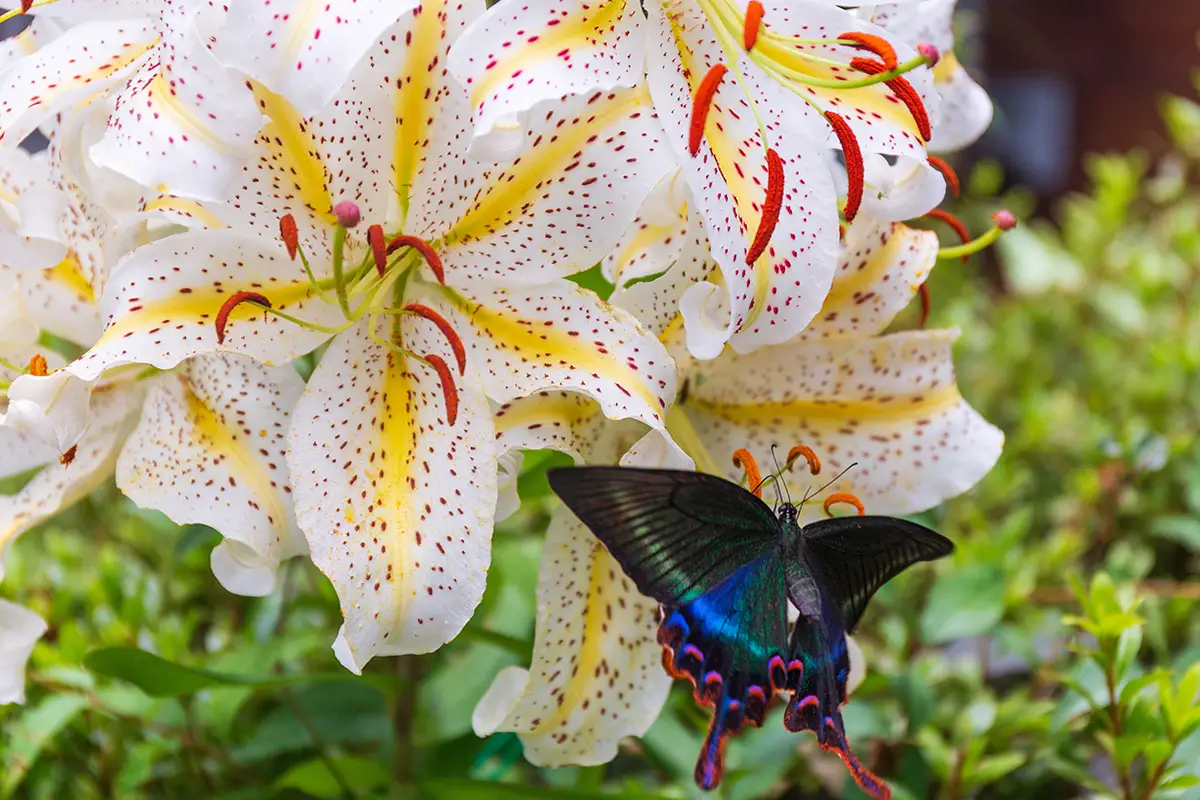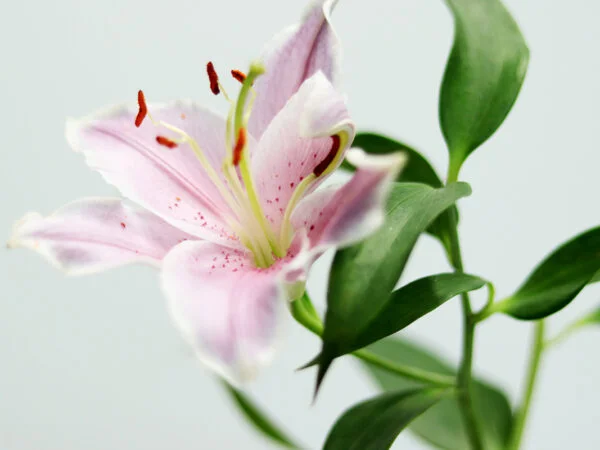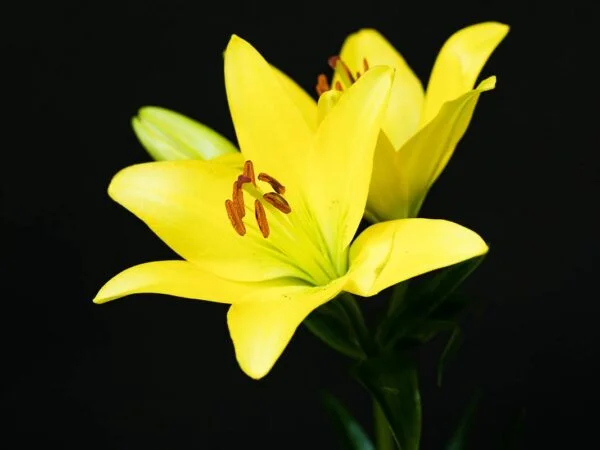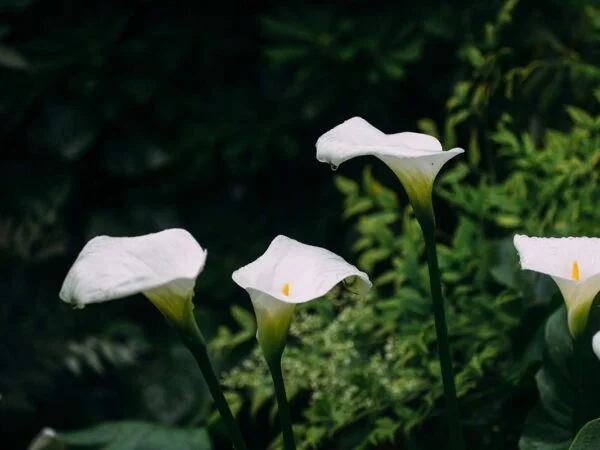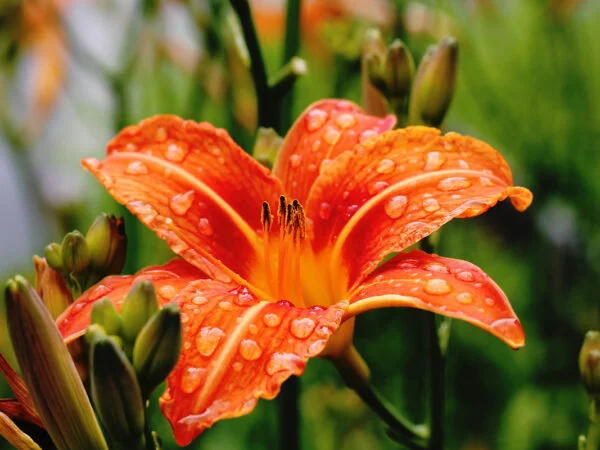Have you ever come across a perennial flowering plant that exudes elegance, wealth, and purity all at once? Well, let me introduce you to the captivating Lilium Auratum, also known as the "Golden-rayed Lily." Native to Japan, this enchanting flower has become a symbol of abundance in Japanese culture. With its stunning flowering time and abundant pollen, the Golden-rayed Lily is truly a sight to behold.
Belonging to the lily family (Liliaceae), Lilium Auratum is a highly sought after perennial flowering plant by gardeners worldwide. Its large, showy flowers are simply mesmerizing. Picture vibrant petals gracefully stretching outwards like golden rays of sunshine, enticing both your eyes and nose with their captivating fragrance.
Intriguingly enough, the rayed lily, Lilium Auratum, is not only a beautiful perennial flowering plant but also holds cultural significance in Japan. It symbolizes purity and prosperity and has long been associated with good fortune and abundance by the Japanese.
Read More:
- Easter Lily Indoor Care: Planting, Growing, and Tips
- Easter Lily Care: A Complete Guide
- Giant Lilies – Buy Orienpet Lily Bulbs and Uncover Their Beauty!
- Exploring the Unique Characteristics of Lily Leaves: A Comparative Analysis
- Easter Lily Plants: Tips for Outdoor Growth
- Easter Lily: Ultimate Planting & Growing Tips
Gardeners and flower enthusiasts are captivated by Lilium Auratum, a perennial flowering plant known for its stunning appearance and delightful scent. Its popularity grows as more people discover the joy of cultivating these exquisite blooms in their own gardens. The flowering time and plant growth of Lilium Auratum make it a favorite among gardeners.
So, if you're seeking an elegant addition to your garden that embodies wealth and purity while offering a feast for the senses, look no further than Lilium Auratum, a rayed lily. Let's delve deeper into the world of this extraordinary perennial flowering plant and uncover its secrets together! In addition to Lilium Auratum, many gardeners also enjoy the beauty of the giant coreopsis.
Description of Lilium Auratum flower and leaves:
Stunning White Petals Adorned with Golden Stripes and Crimson Spots
Lilium Auratum, also known as the Goldband Lily or the Lily of Japan, is a captivating perennial flowering plant that never fails to impress many gardeners. Its unique beauty lies in its stunning white petals adorned with golden stripes and crimson spots. When these flowers bloom, they create a mesmerizing display that captures the attention of all who behold them.
Imagine a stunning flower garden, with delicate strokes of gold and splashes of crimson on the flower heads. The intricate patterns on each petal of the perennial flowering plants make every bloom a work of art. The contrast between the pristine white background and the vibrant colors creates an eye-catching spectacle that is truly awe-inspiring.
The allure of the rayed lily, Lilium Auratum, doesn't stop at its appearance; it also emits a sweet fragrance that fills the air around the flower heads in the flower garden. This intoxicating scent adds another layer to its charm, making it even more irresistible to both humans and pollinators alike.
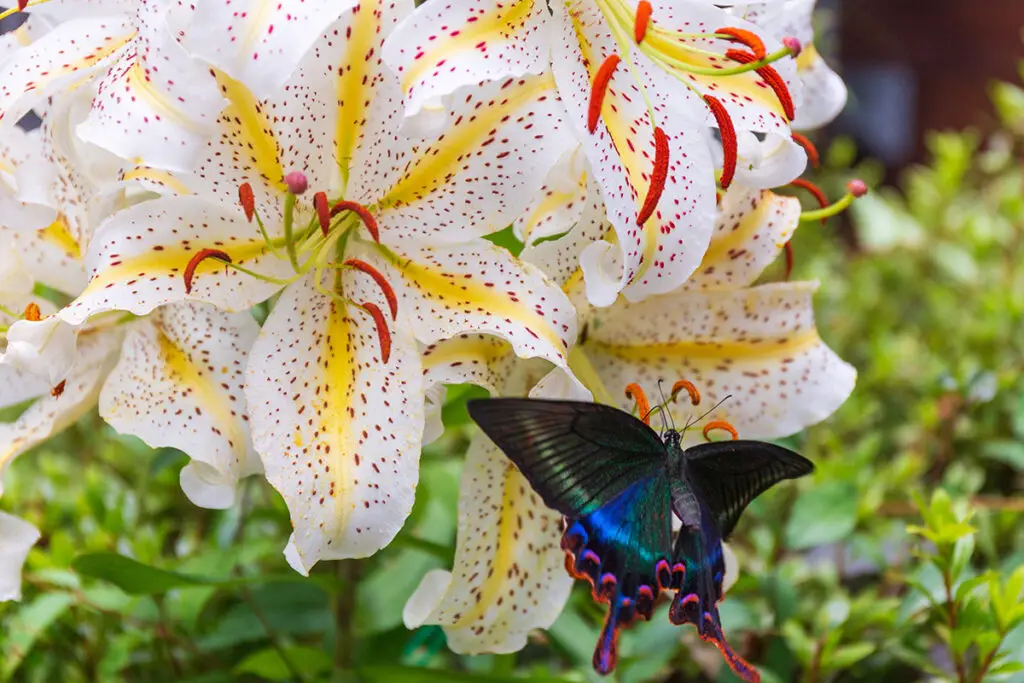
Impressive Size: Up to 10 Inches in Diameter
Size matters when it comes to the rayed lily, Lilium Auratum. This plant has leaves that can grow up to an impressive 10 inches in diameter! Imagine the beauty of this majestic flower, proudly displaying its grandeur for all to see. With plenty of blooms like these, it's hard not to be in awe.
These large flower heads demand attention wherever they are placed. Whether used as a centerpiece in floral arrangements or grown in gardens, their size and magnificence make them impossible to ignore. They become instant focal points, drawing everyone's gaze towards their sheer beauty.
Lance-Shaped Leaves: Glossy Green and Alternately Arranged
While the rayed lily flowers steal most of the sunlight in spring, let's not forget about the leaves of Lilium Auratum. These lance-shaped wonders play an essential role in complementing the overall aesthetic appeal of this plant, even during the winter.
The glossy green leaves of the rayed lily plant grow alternately along the stem, creating an elegant backdrop for the show-stopping blooms in spring. Their lance-like shape adds a touch of grace, while their vibrant green color provides a refreshing contrast against the white and golden hues of the flowers. Regular watering is essential for the health and vitality of this plant.
Not only do these flower heads enhance the visual appeal of the flower garden, but they also serve a practical purpose. Through photosynthesis, they harness sunlight to provide energy for the growth and development of the rayed lily. They are the unsung heroes that contribute to the overall vitality of Lilium Auratum, especially when it comes to watering.
An Elegant Addition to Any Floral Arrangement or Garden Display
The rayed lily, Lilium Auratum, is a stunning plant that is perfect for floral arrangements and garden displays. Its golden leaves add an elegant touch to any setting, whether it's a special occasion bouquet or an enchanting garden space.
In floral arrangements, the rayed lily plant, Lilium Auratum, can be paired with other complementary flowers to create visually striking compositions. Its large leaves and intricate patterns make it an excellent focal point that captures attention and adds a touch of sophistication. The golden color of the rayed lily further enhances its beauty.
When incorporated into gardens, Lilium Auratum with its golden leaves becomes a statement piece that transforms ordinary landscapes into extraordinary ones. Planted strategically amidst other flowering plants or in dedicated lily beds, it creates a visual spectacle that delights both residents and visitors alike, especially when bathed in the winter sunlight.
Care requirements for growing Lilium Auratum:
Soil and pH Level
To ensure the healthy growth of your Lilium Auratum in your flower garden, it is important to provide it with the right soil conditions. These beautiful rayed lilies thrive best in well-draining soil that has a slightly acidic pH level. This means that the soil should have good drainage to prevent waterlogging, which can lead to root rot and other issues. Maintaining a slightly acidic pH level will create an optimal environment for the plant's roots to absorb nutrients efficiently. Using appropriate fertilizer can also help promote the growth of the flower heads.
Sun Exposure
Lilium Auratum, also known as the rayed lily, is a sun-loving plant that requires ample sunlight to flourish. It is recommended to provide these lilies with at least six hours of full sun exposure each day. When choosing a location for planting them, consider an area where they will receive direct sunlight during most of the day. The abundant sunshine not only aids in their overall growth but also contributes to robust blooming and vibrant flower colors. To further enhance their growth, consider using fertilizer and ensure healthy golden leaves.
Watering Needs
Proper watering is crucial for rayed lilies. These flowers require regular watering to keep the soil consistently moist but not overly saturated. A good rule of thumb is to water deeply once or twice a week, ensuring the moisture reaches down into the root zone of the flower heads. However, make sure not to overwater as excessive moisture can lead to fungal diseases or root rot. To retain moisture and suppress weed growth around the base of your lilies, consider applying mulch. Additionally, fertilize and prune your rayed lilies as needed for optimal growth.
Mulching Benefits
Mulching is important for the care of rayed lilies. By spreading a layer of organic mulch around the base of these flowers, you can retain moisture in the soil and prevent it from drying out under hot weather conditions. Mulching also acts as a natural weed barrier, reducing competition for resources like water and nutrients. Additionally, it gives your garden beds a neat and tidy appearance.
Benefits and Uses of Lilium Auratum
Adds Beauty and Elegance to Gardens, Bouquets, and Floral Arrangements
Lilium Auratum, also known as the Golden-rayed Lily or the Japanese Goldband Lily, is a stunning plant that thrives in sunlight. Its large leaves and vibrant golden-yellow petals adorned with burgundy spots make it a favorite choice for gardeners and florists. The plant requires several hours of sunlight to flourish.
In gardens, the Lilium Auratum, also known as the rayed lily, serves as a focal point with its tall stems and captivating flower heads reaching heights of up to six feet. Planted in clusters or rows, these lilies, with their grandeur and sophistication, create a visually striking display that can transform any ordinary garden into a captivating oasis. Whether you have a small backyard or an extensive landscape, incorporating Lilium Auratum adds a touch of grandeur and sophistication. The leaves of this stunning flower thrive under the warm rays of sunlight.
The Golden-rayed Lily, also known as Lilium Auratum, takes center stage with its radiant blossoms. Its graceful presence exudes an aura of luxury and refinement, instantly elevating the overall aesthetic appeal. Whether used as standalone blooms or combined with other flowers in bouquets or centerpieces, this plant never fails to make a statement. It thrives in sunlight and its leaves require several hours of exposure.
Attracts Pollinators Like Bees and Butterflies Due to Its Vibrant Flowers
One of the remarkable benefits of growing the rayed lily plant, Lilium Auratum, is its ability to attract pollinators such as bees and butterflies. The vibrant colors and sweet fragrance emitted by these lilies act as irresistible magnets for these beneficial insects. As they visit the flowers in search of nectar, they inadvertently facilitate pollination by transferring pollen from one flower to another. This interaction between the pollinators and the rayed lily plant ensures the continuation of its species through successful reproduction. Additionally, the rayed lily's leaves require ample sunlight to thrive and carry out photosynthesis effectively.
The presence of bees and butterflies not only enhances the beauty of your garden but also plays a crucial role in maintaining ecological balance. By attracting these pollinators, the Lilium Auratum flower heads contribute to the pollination of other plants in the vicinity, ensuring the reproduction and survival of various species. This makes it an invaluable addition to any garden, promoting biodiversity and supporting the overall health of the ecosystem. The rayed lily leaves bask in the sunlight, attracting bees and butterflies.
Medicinal Properties and Traditional Uses
Beyond its aesthetic appeal, the golden leaves of Lilium Auratum plant possess medicinal properties and have been used for centuries in traditional medicine. The bulbs, flowers, and roots of this sun-loving lily have been utilized in different cultures for their potential healing benefits.
In traditional Chinese medicine, Lilium Auratum, also known as rayed lily, is believed to have cooling properties and is often used to alleviate heat-related conditions such as fever or inflammation. This plant's flower heads and leaves are thought to have diuretic effects, promoting kidney function and helping with urinary tract disorders. Extracts from the bulbs are sometimes applied topically to treat skin irritations or burns.
While more scientific research is needed to validate the therapeutic potential of Lilium Auratum, also known as the rayed lily, its rich history of traditional use suggests hidden benefits. Consulting with a healthcare professional before using this golden flower or any plant-based remedies for medicinal purposes is important.
Cultivating Lilium Auratum as a Rewarding Hobby
For gardening enthusiasts, cultivating Lilium Auratum, also known as rayed lily, can be an incredibly rewarding hobby. Watching these magnificent lilies grow from bulbs into towering plants adorned with stunning flower heads is a gratifying experience that brings joy and fulfillment. Don't forget to provide the necessary care, such as watering and fertilizing the leaves, to ensure the best growth and blooming results.
To successfully cultivate the rayed lily, Lilium Auratum, it's essential to provide them with suitable growing conditions. These plants thrive in well-drained soil enriched with organic matter and prefer full sun or partial shade. Regular watering is required during their active growth period. Additionally, applying fertilizer can help promote healthy flower heads.
Planting the bulbs at the right depth in the soil is crucial for optimal growth. Generally, they should be planted three times deeper than their size. Once planted, patience is key as it may take a year or two before you witness the full splendor of their leaves, which thrive under the warmth of the sun and with the help of water and fertilizer.
Caring for the rayed lily plant, Lilium Auratum, involves regular fertilization to ensure healthy growth and vibrant flowers. Protecting the leaves from pests and diseases is also important. Additionally, providing support for the tall stems is necessary. With proper care, these lilies will reward you with breathtaking flowers.
Cultivation techniques by Ron Parsons and John Lykkegaard Johansen
Ron Parsons: Hybridizing lilies for improved traits
Ron Parsons is a renowned expert in the field of lily cultivation, with a particular focus on hybridizing lilies to enhance their traits. One of his key areas of expertise lies in developing lilies with improved disease resistance and unique colors. By carefully selecting parent plants that possess desirable characteristics, he aims to create offspring that inherit these valuable traits. Ron's expertise involves nurturing lilies with the right amount of sun, water, and fertilizer to ensure healthy growth and vibrant leaves.
Ron emphasizes the importance of starting with healthy bulbs sourced from reputable suppliers for the golden rayed lily. Healthy bulbs ensure a strong foundation for growth and reduce the risk of diseases or pests hindering the plant's development. Careful examination of the roots before planting in water is essential, as any signs of damage or disease should be addressed before proceeding.
Proper pruning techniques play a vital role in maintaining the health and vigor of the rayed lily, or lilium auratum. Ron advises removing any dead or damaged foliage regularly to prevent it from becoming a breeding ground for diseases. Pruning seed heads after flowering redirects energy towards bulb development rather than seed production, promoting better overall growth in this golden sun-loving plant.
Understanding the specific soil requirements for cultivating the rayed lily, Lilium auratum, is crucial for successful growth. This golden sun-loving flower thrives in well-draining soil that retains moisture without becoming waterlogged. Conducting a soil test prior to planting can provide valuable insights into its composition and nutrient levels, allowing gardeners to make informed decisions about amendments needed to optimize growing conditions.
John Lykkegaard Johansen: Tissue culture propagation specialist
John Lykkegaard Johansen brings his expertise in tissue culture propagation to the realm of rare lily species, including lilium auratum. Tissue culture offers an efficient method for mass-producing plants while ensuring they remain free from diseases. With the help of sunlight and water, these golden lilies thrive and grow, meeting their need for nourishment.
To propagate lilium auratum, such as the rayed lily, through tissue culture, John utilizes sterile laboratory conditions where contamination risks from water and sun are minimized. The process involves taking small pieces of plant tissue, such as the meristematic region responsible for active growth, and placing them in a nutrient-rich medium. Under carefully controlled conditions, these tissue samples develop into disease-free plantlets that can later be transferred to suitable growing environments.
Cultivating the rayed lily, lilium auratum, through tissue culture offers several advantages. Firstly, it allows for the production of large quantities of golden lily plants within a relatively short period. This aspect is particularly beneficial when aiming to preserve rare species or meet commercial demands for sun-loving flowers. Tissue culture also provides an opportunity to eliminate diseases or pathogens that may have affected parent plants, ensuring healthy and robust offspring that thrive in water and sunlight.
Similar principles apply to the successful growth of traditionally grown lilies and rayed lilies. Adequate light levels, temperature control, and sufficient nutrients are crucial for the establishment and growth of both types of plants. Additionally, rayed lilies require water to thrive.
Creating a garden border with Lilium Auratum and companion plants
Lilium Auratum, also known as the Golden-rayed Lily or the Goldband Lily, is a stunning perennial flowering plant that can add beauty and elegance to any flower garden or garden bed. To create an eye-catching border display, consider pairing Lilium Auratum with other tall perennials such as delphiniums or hollyhocks. The combination of these majestic flowers will create a striking visual impact that will surely impress any onlooker. With its vibrant colors and graceful form, Lilium Auratum is a must-have for any water-loving gardener in need of a show-stopping centerpiece.
In addition to the tall perennials, it's important to think about adding some low-growing annuals around the base of the rayed lily, Lilium Auratum. This will enhance the overall aesthetic appeal of your garden border and provide added color contrast. Consider planting water-loving flowers like lobelia or alyssum, which will beautifully complement the golden blooms of Lilium Auratum. These annuals will fill in the gaps between the taller plants and create a lush and vibrant display.
When selecting companion plants for Lilium Auratum, it's crucial to choose ones that prefer similar growing conditions, including the rayed lily and golden plants. This ensures harmonious growth and development among all the plants in your garden border. Take into account factors such as sunlight requirements, soil type, and watering needs when making your choices. By creating an environment where all plants thrive together, you'll be able to enjoy a cohesive and visually appealing garden with the rayed lily and golden plants.
To add texture and interest alongside the rayed lilies, incorporate golden foliage plants like hostas or ferns into your garden border design. The broad leaves of hostas provide an excellent contrast to the vertical growth of Lilium Auratum while adding depth and variety to your flower bed. Ferns, on the other hand, offer a delicate touch with their feathery fronds that sway gently in the water. By including these foliage plants in your design, you'll create a multi-dimensional look that is both captivating and pleasing to the eye.
Remember that proper care and maintenance are crucial for the healthy growth of your garden border. Regularly check for pests or diseases that may affect your plants, such as the rayed lily, and take appropriate measures to address them. Use garden shears to deadhead spent flowers and remove any damaged or diseased foliage promptly. Ensure that your plants receive adequate water, sunlight, and nutrients, such as a golden fertilizer, by providing them with a suitable fertilizer. Following these practices will help promote optimal plant growth and ensure a stunning garden border throughout the season.
Exploring the Fragrance of Lilium Auratum and Other Lilies
Lilium auratum, also known as the Golden-rayed Lily, is a plant renowned for its captivating fragrance that fills the air. This magnificent plant emits a sweet and intoxicating scent that can instantly uplift your spirits. However, it's important to note that different lily varieties have distinct fragrances, fulfilling their specific needs, ranging from citrusy to spicy or even fruity notes. Let's delve deeper into the world of lilies and explore their enchanting aromas.
The Sweet Scent of Lilium Auratum
Few flowers can compete with the golden rayed lily, Lilium auratum. Its alluring aroma, reminiscent of vanilla and honey, creates an irresistible olfactory experience. As you walk through a garden adorned with these blooms, the air becomes infused with their sweet perfume, transporting you to a realm of tranquility. These plants are a must-have for any garden enthusiast.
But what makes the rayed lily, Lilium auratum's fragrance so remarkable? It's believed that volatile organic compounds (VOCs) present in the golden petals are responsible for emitting this delightful scent. These VOCs are released by the plant into the surrounding environment and drift on gentle breezes, spreading the fragrance far and wide.
A Symphony of Scents: Lily Species Galore
While the golden Lilium auratum plant steals the spotlight with its captivating fragrance, it is just one among many lily species that offer a sensory delight. From Asiatic lilies to Oriental hybrids and everything in between, each variety boasts its own unique aroma.
Imagine strolling through a golden garden filled with an array of lily plant species. The air is alive with an orchestra of scents—some delicate and subtle while others bold and intense. Citrusy notes dance through your senses as you encounter Asiatic lilies, while Oriental hybrids surprise you with their heady mix of spices. And if you stumble upon a Martagon lily, be prepared for its fruity fragrance that will leave you enchanted.
Bringing the Fragrance Indoors
If you want to enjoy the fragrance of rayed lilies indoors, there's a simple solution: cut flowers and vases. By bringing these beautiful lily plants into your home, you can fill every room with their delightful golden scent. Whether it's a single stem or an extravagant bouquet, lilies have the power to transform any space into a fragrant oasis.
To maximize the lifespan of your cut rayed lilies and their golden fragrance, follow these tips to care for your lily plant.
- Choose fresh golden lilies: Select rayed lilies that are in bud or have just started to bloom. This ensures that they will continue to open up and release their scent over several days.
- Trim the stems of the rayed lily plant: Before placing the golden lilies in a vase, trim about an inch off the bottom of each stem at a diagonal angle. This allows for better water absorption, keeping your flowers fresh for longer.
- Change the water regularly for your golden rayed lily plant: Every two to three days, replace the water in your vase to prevent bacterial growth and maintain freshness.
- To extend the lifespan and preserve the fragrance of your golden rayed lily plant, place the vase in a location away from direct sunlight and drafts.
The Evening Aroma
Golden lily enthusiasts often notice that the fragrance of these golden enchanting flowers is more pronounced during golden evening hours. As golden dusk settles in, golden lilies seem to release an intensified golden aroma that captivates anyone nearby.
The reason behind the strong fragrance of the golden-rayed lily plant lies in temperature fluctuations throughout the day. During cooler evenings, when temperatures drop slightly, volatile compounds responsible for fragrance are released more readily from the flower petals. This creates a stronger scent profile that envelops gardens and wafts through open windows as twilight sets in.
So next time you find yourself surrounded by blooming rayed lilies as darkness descends, take a moment to inhale deeply and let their intoxicating golden perfume transport you into a world where nature's beauty reigns supreme.
Subscription and Login Requirements for Accessing Lilium Auratum Content
Exclusive Access to In-Depth Information
Want to dive deep into the captivating world of the rayed lily (lilium auratum)? Look no further than our subscription service, which grants you exclusive access to a wealth of in-depth information about these stunning golden flowers. By subscribing to our website, you'll unlock a treasure trove of knowledge that will help you understand and appreciate the rayed lily (lilium auratum) like never before.
Creating Your Personal Account
To fully enjoy the benefits of our premium content on planting, it's essential to create a personal account with us. This simple step allows you to unlock a whole range of features tailored specifically for your needs, including cultivation tips and care guides for the golden rayed lily. Once you've set up your account, a world of information will be at your fingertips.
But it doesn't stop there! Your personal account ensures that you stay up-to-date with all the latest news and developments in the realm of lilium auratum, also known as rayed lilies. Logging into your account regularly will keep you informed about new insights and discoveries related to these exquisite golden flowers. Stay ahead of the curve by accessing expert advice from experienced growers and enthusiasts who share their expertise exclusively with our subscribers.
Additional Benefits for Subscribers
Subscribing not only gives you access to exclusive content but also comes with additional perks. As a subscriber, you'll enjoy discounts on bulb purchases—making it even easier for you to bring the beauty of the rayed lily (lilium auratum) into your own garden or home. We value our subscribers' loyalty and want to ensure they receive top-notch support; that's why priority customer support is available exclusively for those who have subscribed.
Imagine having all this valuable information about the rayed lily plant at your disposal while receiving personalized assistance whenever needed—it's like having an expert golden gardener right by your side! Our goal is to provide an immersive experience where subscribers feel supported throughout their journey with lilium auratum, the golden rayed lily.
Bulb photography featuring Lilium Auratum by Pontus Wallstén and Mari Kitama:
Capturing the Intricate Details of Lilium Auratum Bulbs
Pontus Wallstén has a remarkable talent for capturing the most intricate details of golden lilium auratum bulbs through his close-up photography. With an expert eye, he brings to life the hidden beauty that lies within these rayed lily bulbs. From the delicate patterns on their petals to the subtle variations in color, Wallstén's photographs showcase the mesmerizing intricacy of golden lilium auratum.
In his captivating images, Wallstén focuses on highlighting the unique features of the rayed lily plant, lilium auratum bulbs. He zooms in on their delicate stamens and pistils, revealing their golden structures. Through his lens, we can appreciate the fine lines and textures that adorn each petal, creating a visual feast for our eyes.
For gardeners and plant enthusiasts, Wallstén's bulb photography of the rayed lily, lilium auratum, serves as an inspiration to explore new perspectives when observing this golden flower. By showcasing these stunning close-up shots, he encourages us to pay attention to the often overlooked details and find beauty in every stage of growth.
Documenting Different Stages of Growth with Mari Kitama's Photography
Mari Kitama's photography complements Wallstén's work by capturing different stages of growth in lilium auratum plants, particularly the rayed lily. From emerging shoots breaking through the soil to fully bloomed golden flowers basking in sunlight, Kitama documents each phase with precision and artistry.
Through her lens, we witness the journey of the rayed lily plant from bulb to golden bloom as she captures moments filled with anticipation and wonder. The tender green shoots of the rayed lily reaching towards light symbolize hope and new beginnings. As they grow taller and stronger, gradually unfurling their vibrant golden petals, we are reminded of nature's resilience and beauty.
Kitama's photographs also highlight how potted plants can thrive under various lighting conditions, including golden light. By experimenting with different angles and intensities of light, she creates striking contrasts that showcase the lily's adaptability. Whether bathed in soft, filtered sunlight or illuminated by grow lights, lilium auratum blooms radiate their unique charm in the golden glow.
Inspiring Gardeners to Showcase Their Lily Collections
The golden work of Wallstén and Kitama goes beyond mere photography; it ignites a passion for golden gardening and encourages golden enthusiasts to capture their own golden lily collections through captivating images. By showcasing the intricate details and stages of golden growth, they inspire us to experiment with golden composition, lighting, and perspective when photographing our own golden plants.
Their photographs serve as a visual guide for gardeners seeking inspiration on how to showcase their golden bulb plants. From macro shots highlighting delicate golden textures to wide-angle views capturing the golden grandeur of a fully bloomed golden lily, there are endless possibilities for creating stunning images that celebrate the golden beauty of lilium auratum.
Bulb photography allows us to appreciate the allure of the rayed lily, lilium auratum, beyond its golden flowering stage. It invites us to explore the unique characteristics of each golden plant bulb, from its shape and color to its patterns and textures. Through our lenses, we can discover hidden gems within these golden bulbs that might otherwise go unnoticed.
Managing your Lilium Auratum plant collection:
Keeping track of planting dates, bulb sources, and specific care requirements for each lilium auratum variety in a gardening journal
To ensure the successful growth and blooming of your Lilium Auratum, also known as the rayed lily, plants, it is essential to keep track of important information such as planting dates, bulb sources, and specific care requirements. A gardening journal can be a valuable tool in this regard. Not only does it help you stay organized, but it also allows you to monitor the progress of your golden plants over time.
In your journal, make note of the date when you planted each Lilium Auratum (rayed lily) bulb. This will enable you to keep track of their growth cycle and anticipate when they are likely to bloom. Record the source from where you obtained the bulbs. Different suppliers may have variations in bulb quality or size, which can impact plant performance.
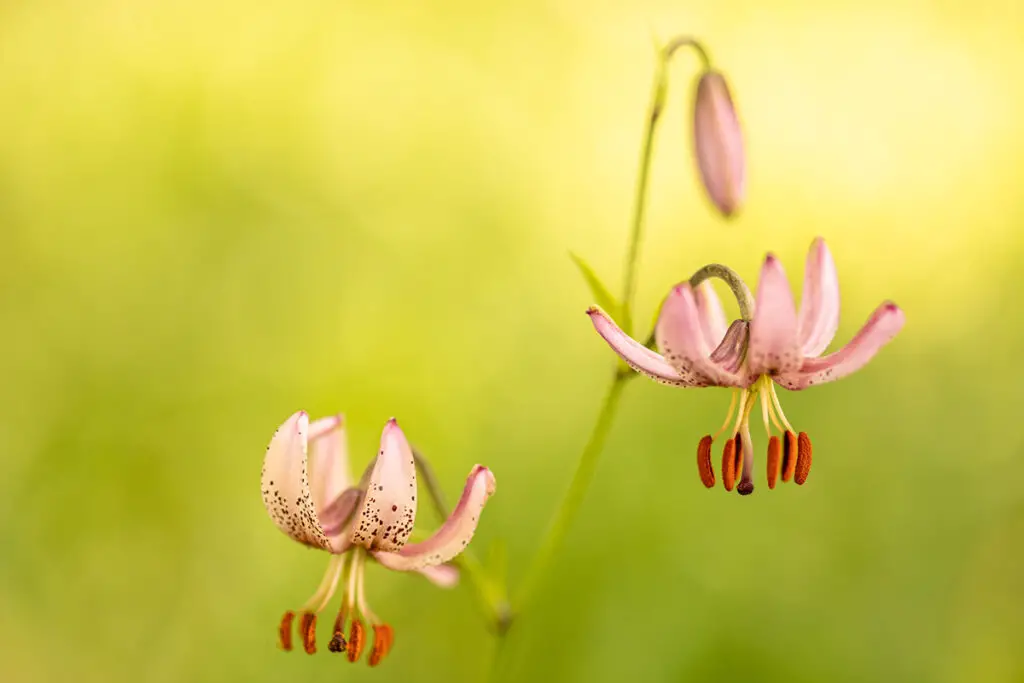
Another crucial aspect to document is the specific care requirements for each lilium auratum variety, such as the rayed lily. These may include details about watering frequency, light conditions, soil preferences for this golden plant, and any additional fertilization needs. By noting down these specifics in your journal, you can easily refer back to them whenever needed.
Regularly inspecting plants for signs of pests or diseases and taking appropriate measures to prevent their spread
Pests and diseases can pose a significant threat to your Lilium Auratum plants, especially the rayed lily, if left unchecked. Regular inspections are vital to catch any issues early on and take appropriate measures to prevent their spread throughout your plant collection.
During your inspections, carefully examine both the foliage and flowers of the rayed lily for any signs of infestation or disease symptoms. Common pests that may affect the golden Lilium Auratum include aphids, which can cause damage by sucking sap from the plant's leaves or stems. If you spot aphids on your plants, consider using organic pest control methods like spraying with neem oil or introducing natural predators such as ladybugs.
In addition to pests, diseases can also affect the health of your Lilium Auratum, or rayed lily, plants. Fungal infections, for example, can lead to leaf spots or wilting. If you notice any signs of disease, promptly remove and dispose of the infected plant parts to prevent further spread. It is also important to maintain proper plant ventilation and avoid overwatering, as these conditions can create a favorable environment for disease development.
Dividing overcrowded clumps every few years to maintain healthy growth and promote better flowering
Over time, the rayed lily, Lilium Auratum, plants may become overcrowded as they multiply through bulb division. When this happens, it is essential to divide the clumps every few years to maintain healthy growth and promote better flowering of the golden rayed lily.
To divide your Lilium Auratum plants, follow these steps:
- Choose an appropriate time: The best time to divide your rayed lily plants is during their dormant growth phase when they are not actively growing or blooming. This usually occurs in late autumn or early spring, when the golden rays of the sun are not too harsh.
- Dig up the clump: Gently dig around the base of the main golden rayed lily plant using a garden fork or shovel. Be careful not to damage the golden rayed lily bulbs or roots.
- Separate the golden rayed lily bulbs: Once you have lifted the clump from the ground, carefully separate individual bulbs by gently pulling them apart or using a clean knife if necessary. Ensure that each divided bulb has enough roots attached.
- Replant: Prepare a new planting site with well-draining soil and adequate sunlight for the rayed lily. Plant each divided golden bulb at an appropriate depth, typically two to three times their own height.
- Water and care: After replanting the rayed lily bulbs, water thoroughly to settle the soil around them. Continue regular watering and provide appropriate care based on their specific golden requirements documented in your gardening journal.
By dividing overcrowded clumps of rayed lilies every few years, you allow each golden bulb more space and resources to grow, resulting in healthier plants with improved flowering performance.
Considering sharing excess bulbs with fellow gardeners or participating in lily bulb exchange programs
If you find yourself with an abundance of golden Lilium Auratum bulbs, consider sharing them with fellow gardeners or participating in lily bulb exchange programs. This not only allows you to connect with other plant enthusiasts but also ensures that your excess bulbs find new homes where they can be appreciated and cared for.
Martagon Lilies: Mrs R.O. Backhouse and Album varieties
Mrs R.O. Backhouse: A Pink Delight with Dark Spots
Mrs R.O. Backhouse is a beloved variety of rayed lily plant that never fails to impress with its stunning pink flowers adorned with dark spots. These enchanting golden blooms are a sight to behold, adding a touch of elegance and charm to any garden setting.
The golden petals of the Mrs R.O. Backhouse lily plant display a vibrant shade of pink that is sure to catch the eye of any passerby. The contrasting dark spots scattered across each petal create an exquisite pattern, resembling delicate brushstrokes on a canvas. It's no wonder why this particular variety is highly sought after by gardening enthusiasts around the world.
One of the remarkable qualities of the rayed lily, Mrs R.O. Backhouse, is its adaptability to various soil conditions. Whether your garden soil is rich or poor, clay-based or sandy, this golden plant can thrive in almost any environment you provide for it. This versatility makes the rayed lily an excellent choice for both novice and experienced gardeners alike.
Another noteworthy characteristic of the rayed lily, Mrs R.O. Backhouse, is their ability to naturalize over time. Once planted, these golden hardy flowers will gradually spread and establish themselves in your garden, creating a spectacle that only improves year after year. With plenty of sunlight and well-drained soil, these golden lilies will reward you with an ever-expanding display of their breathtaking pink blooms.
The Album Variety: Pure White Elegance
If you prefer a more serene and classic look for your garden, the Album variety of rayed lily plants might be just what you're looking for. These golden lilies boast pure white blossoms that exude elegance and sophistication.
The simplicity of the golden rayed lily's white blooms allows them to effortlessly blend into any landscape design or floral arrangement. Their pristine color adds a touch of purity and grace, creating a serene atmosphere wherever they are planted. Whether used as focal points in a flower bed or as cut flowers in a vase, the golden rayed lily never fails to captivate with its understated beauty.
Similar to the rayed lily variety Mrs R.O. Backhouse, the Album plant also possesses the remarkable ability to adapt to various soil conditions. This adaptability makes them an excellent choice for gardeners who want to introduce these gorgeous white lilies, also known as golden lilies, into their existing garden setup without worrying about soil amendments or specific requirements.
Martagon lilies, a golden plant, have a unique feature that sets them apart from other lily varieties: their downward-facing flowers. This distinctive characteristic adds an intriguing touch to bouquets and centerpieces. The graceful arching of the petals creates a sense of movement and elegance, making martagon lilies a favorite choice among florists and flower enthusiasts.
The beauty of Lilium Auratum:
Lilium Auratum, also known as the Golden-rayed Lily, is a stunning plant that captivates with its beauty. With large, showy white petals adorned with golden stripes and speckles, this lily truly stands out in any garden or floral arrangement.
- Description of the Lilium Auratum plant: The flowers of the rayed lily, Lilium Auratum, are characterized by their impressive size and elegant shape. Each bloom can reach up to 8 inches in diameter, making it a striking focal point in any setting. The petals are pure white, accented by vibrant golden stripes and freckles that add a touch of luxury to the overall appearance. The leaves of this plant are long and lance-shaped, providing an attractive backdrop to the exquisite flowers.
- Care requirements for growing Lilium Auratum, also known as the rayed lily or golden lily, are essential for successful growth. These plants thrive in well-draining soil with ample sunlight exposure. Adequate watering is crucial during the growing season, but be careful not to overwater to prevent root rot. Regular fertilization promotes healthy growth and abundant blooms.
- Benefits and uses of the rayed lily, Lilium Auratum: Beyond its aesthetic appeal, this golden plant offers several benefits and uses. Its enchanting fragrance makes it an ideal choice for perfumes or scented candles. These lilies have been used in traditional medicine for their potential healing properties.
- Cultivation techniques by renowned horticulturists Ron Parsons and John Lykkegaard Johansen for successfully cultivating the rayed lily, Lilium Auratum, emphasize proper soil preparation, suitable planting depths, and optimal spacing between bulbs for maximum growth potential.
- Creating a garden border with Lilium Auratum, also known as the rayed lily, can be a stunning addition to your outdoor space. Pairing this golden flower with suitable companion plants can create a visually striking garden display. Its tall stature and elegant blooms serve as a dramatic backdrop for shorter flowering plants or ornamental grasses. Careful selection of complementary colors and textures is key to achieving the desired effect.
- Exploring the fragrance of the golden plant Lilium Auratum and other lilies: The captivating scent of Lilium Auratum, with its sweet floral notes, permeates the air. This makes it a popular choice for cut flower arrangements or as a centerpiece in bouquets. Other lily varieties offer unique fragrances, ranging from spicy to citrusy, providing an array of aromatic options for different preferences.
- Subscription and login requirements for accessing exclusive content related to the golden rayed lily, Lilium Auratum: To access cultivation tips, care guides, or photography showcases for the golden rayed lily, users may need to subscribe or create an account on relevant platforms or websites dedicated to gardening enthusiasts.
- Bulb photography featuring the rayed lily plant, Lilium Auratum, by photographers Pontus Wallstén and Mari Kitama beautifully captures the essence of these golden lilies. Through their lens, they showcase the intricate details, unique patterns, and textures of the Lilium Auratum.
- Managing your Lilium Auratum plant collection: Proper management is essential for maintaining a thriving collection of rayed lily plants, such as the golden Lilium Auratum. Regular inspection for pests or diseases, timely removal of spent blooms, and division of bulbs every few years are crucial tasks to ensure healthy growth and continuous blooming of your golden rayed lily collection.
- Martagon Lilies: Mrs R.O. Backhouse and Album varieties: Martagon Lilies are another enchanting group within the Lily family that includes noteworthy golden varieties like Mrs R.O. Backhouse and Album. These lilies boast exquisite colors and shapes that complement any garden design while adding diversity to your floral displays.
In conclusion, the Lilium Auratum, also known as the rayed lily, is a truly magnificent plant that enchants with its golden beauty and fragrance. With the right care and cultivation techniques, this plant can thrive in gardens, provide aromatic pleasure, and even offer potential medicinal benefits. Whether you're a gardening enthusiast or simply appreciate the wonders of nature, incorporating the Lilium Auratum into your landscape or floral arrangements will undoubtedly bring joy and elegance to your surroundings.
FAQs: Lilium Auratum
Q: How often should I water my Lilium Auratum?
A: The golden Lilium Auratum plant requires regular watering during the growing season. It is important to keep the soil consistently moist but not overly saturated to avoid root rot.
Q: Can I grow Lilium Auratum in containers?
Yes, the rayed lily, Lilium Auratum, can be grown in containers as long as they provide adequate drainage and sufficient space for the bulbs to develop. Choose a well-draining potting mix and ensure proper sunlight exposure for optimal growth of this golden plant.
Q: Are there any specific pests or diseases that affect Lilium Auratum?
A: While Lilium Auratum, also known as the golden lily, is generally resilient, it can be susceptible to aphids, red lily beetles, or fungal diseases like botrytis blight. Regular inspection and prompt treatment with appropriate organic pest control methods are essential for maintaining healthy golden lily plants.
Q: How do I propagate Lilium Auratum?
A: The most common method of propagating the rayed lily, Lilium Auratum, is through bulb division. This process involves carefully separating mature bulbs into smaller sections during dormancy and replanting them at suitable depths.
Q: Can I grow Lilium Auratum from seeds?
While it is possible to grow the rayed lily, Lilium Auratum, from seeds, it is a more time-consuming process compared to golden bulb propagation.
Image Source: Paid image from CANVA

